WHEN PEOPLE TALK ABOUT DISHES INVENTED in Chicago, they usually talk about deep dish pizza, or maybe Shrimp DeJonghe. One that never gets mentioned is Akutagawa, which is basically scrambled eggs cooked full of Asian ingredients like bean sprouts and drizzled with gravy, specialty of the now-gone diner Hamburger King in the old Japanese enclave in Wrigleyville. (It’s still served at Rice & Bread, which took over the space a few years ago.) It’s a classic example of the kind of Asian-fusion comfort food we associate with Navy cooks in the Pacific, slinging hash with local ingredients mixed in while contributing items from their own stores—like Spam—to the locals’ cuisine.
Of course, though things like Spam musubi in Hawaii or spaghetti with hot dogs in the Philippines are dishes with a genuine historical pedigree by now, Asian fusion is a bad word in many circles. “Mentaiko spaghetti is on our menu,” says Mark Hellyar, chef of Momotaro in the West Loop, speaking of a Japanese dish in which pink spicy cod roe takes the visual place of tomato sauce. “And sometimes people come here and go, ‘Oh, it’s a fusion restaurant, they have spaghetti.’ But it’s a real Japanese dish from the 1950s.”
Japan being Japan, they can make comfort food, even drunk food, of unexpected elegance and refinement, and one example of that is what’s known as omurice, a loanword that combines omelet and rice. Which is precisely what it is—fried rice with an omelet on it. And ketchup. (We’ll get to the elegance and refinement in a minute, I promise.)
“Omurice has just recently become really popular” in Japan, says Erik Bentz, who is the chef de cuisine of The Izakaya, Momotaro’s more laid-back downstairs bar. “But it’s been done forever—it goes back to the yoshuku [Westernized food] restaurants of the 1950s.” He asks if I’ve ever seen Tampopo, the 1980s international hit movie from Japan about a restaurant; I explain that my whole family watched it before we went to Japan a couple of years ago. “Well, that’s how, when I was younger, I first saw omurice, and I was like, what is that?”

Erik Bentz flipping his omelet
Hellyar got interested in the idea of doing dishes inspired by omurice at Momotaro last year. “The difficulty level made us really curious at first,” he says. “But I had to see who had the time to practice to get it perfect. Erik took the slower times in the winter to work on it as a dish for The Izakaya. The key thing was wanting it to be really perfect—not winging it but doing it at an impressive level.”
I ask if there’s anything special about the rice. “Some people dry the rice,” Bentz explains. “The Japanese, with fried rice, tend to use fresh rice, so we use fresh white rice, Maggi [sauce], shishito peppers, carrots, scallions—we keep it real simple, then the beef. We finish it with soy sauce, which isn’t usually done in Chinese fried rice but the Japanese almost always use shoyu.”
“Traditionally it’s made with ketchup-fried rice,” Bentz explains, “but westerners are kind of weirded out by the ketchup-fried rice, so we had to change it a little bit.” The answer is a sauce they concocted that has something of ketchup’s umami robustness, but tastes a little more complex and sophisticated, like a French bordelaise crossed with steak sauce.
“I like the sauce on top—it makes a big difference, the acidity,” Hellyar says.
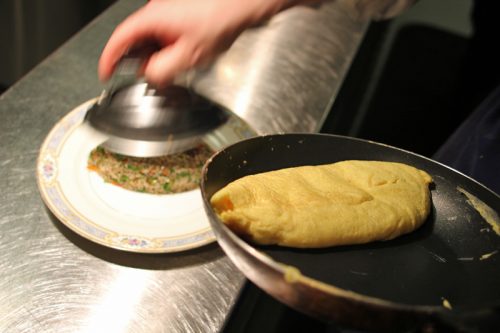
What it looks like as the components are ready to be plated. A second after I snapped this, Bentz decided the omelet wasn’t perfect enough and went back to make a better one.
A scoop of the fried rice is plated in a football shape, and then a cover is placed over it. The next step is the trickiest—the omelet. “There’s no seam,” Hellyar says, a bit cryptically. I soon see what he means. Bentz is making, again, a football shaped omelet—but he keeps turning it (with chopsticks, no less) as it cooks. The goal is to produce a continuous football shape with no obvious place where the sides came together. The reason for that will become evident at table side.
During a busy service, it will drive you completely insane, trying to pull it off. Because you’ll be going super smooth, and then you’ll have one omelet go wrong.
Finally he gets it just right—and now the clock is ticking. The lid is lifted and the omelet is carefully slid onto the fried rice—draping it over the rice like a giant piece of nigiri. Bentz walks toward the table with the plate and a china bowl of the sauce.
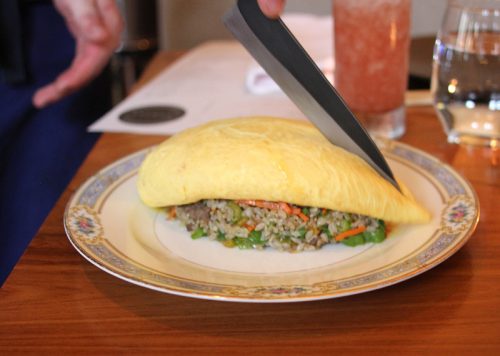
The omelet is slit open…
At our table he pulls out a sashimi knife and slices the omelet down the middle—it opens perfectly, like some kind of creature being gutted, falling to both sides and revealing a gooey interior of not-fully-cooked egg. Then he pours the sauce over the top. Fried rice, creamy egg, savory sauce—it’s a diner meal, messy and full of savory comfort, yet performed with a dancer’s artistry. How beautifully Japanese, we think—in the last moment before we tear into it like a couple of eggs over easy with hash browns at a diner counter.
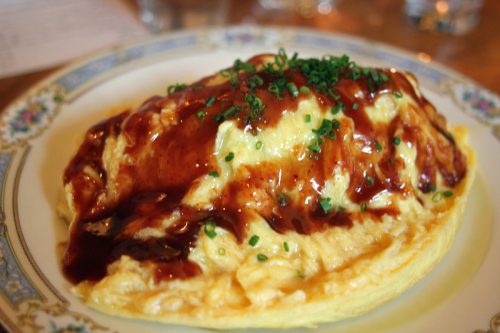
…and the still-creamy insides are drizzled with sauce
“It’s nice because you just don’t see it everywhere,” Bentz says. “During a busy service, it will drive you completely insane, trying to pull it off. Because you’ll be going super smooth, and then you’ll have one omelet go wrong, and you just have to calm yourself down and say, all right, let’s fire another one.”
It’s only served in the izakaya, and the 20 or so they make on a busy night is about all they can handle. “If we served it up here, we’d sell 60 of them and there’d be one guy just doing fried rice all night,” Bentz says. “It’s a two man job—one guy’s cooking the rice, one guy’s frying the eggs.”
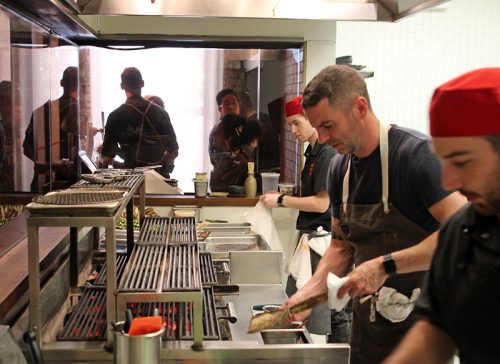
Mark Hellyar (center) puts a chimaki on the grill
“NORMALLY WE DON’T ALLOW BLACK COD in this restaurant,” Hellyar says. It’s a beautiful, buttery fish, but the chef Nobu Matsuhisa’s miso-marinated black cod recipe became a ubiquitous cliché of Asian fine dining and fusion in the 1990s. “You go to a lot of Japanese restaurants and they always have the staples, like the tuna crispy rice, tempura edamame, black cod,” he says.
Once they mastered the omurice, Hellyar wanted a rice dish with a similar comfortingness—but not the diner vibe—for the main dining room upstairs. He found it in chimaki, a dish of rice and other flavors stuffed inside a bamboo leaf and steamed; in Kyoto you’ll see an arrangement of bamboo leaf and straw representing chimaki hanging outside homes there as a good luck charm. Chimaki is usually referred to as a type of dumpling, though to Western eyes another word comes to mind—tamale.
In Japan chimaki are often sweet, but like a tamale, you can do whatever you want with the basic form. Hellyar’s version stuffs the banana leaf with black cod and rice flavored with dashi and bits of preserved kombu seaweed and shiitake mushrooms.

“We braise kombu every day, because we make dashi,” Hellyar says. “I was talking to one of my friends who has a restaurant in L.A. He trained in kind of old world Japanese preparation in Kyoto, and so he’s really into preservation,” like tsukudani, a traditional way of preserving kombu. “After I talked to him, I said, we’re going to start preserving things like kombu and shiitakes, and aging shiitakes for a year.”
So once they had the rice with the preserved flavors, Hellyar reconsidered his stance on black cod. “That fish just has a lot of stickiness, a lot of moisture, so it’s very difficult to overcook,” making it ideal for a preparation that has to sit in the steamer a long time—and also doesn’t allow the cook to see inside its wrapper to judge how the fish is doing. “We marinate it in koji [a fungus that helps produce many Japanese staples, such as soy sauce and miso], so there’s another preservation method in the dish. That way, when it cooks together, you feel like all the juices that come out of the tsukudani and the fish all come together nicely in a creamy texture.”
When an order comes in, the chimaki moves from the steamer to the binchotan grill, picking up smoky flavors as the bamboo leaf sits atop the flames. At table side the chimaki’s binding is snipped and it’s opened to reveal a triangle of flavorful rice and black cod, which you mix together with a blunt wooden spoon.
The result—rich, a bit oily from the beautiful black cod and juicy with deep flavors from the preservation, is incredibly satisfying and comforting.
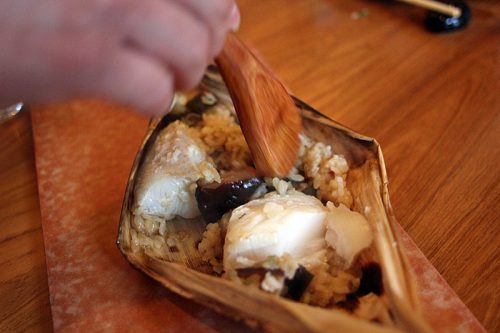
Not surprisingly, it’s been a hit. “That one sells out every night. We make 22 a night, 40 on weekends, and we sell it out, because you can’t sell it the next day. It has to be made that day, we don’t let the rice get cold.”
“I love adding a little smoke flavor at the end,” Hellyar says. “When you go into some restaurants and they’re cooking with lots of wood and grills, you leave without ever tasting it. And I’m always baffled by that. I want to taste the smoke. It’s fun when you can taste it.”
Michael Gebert is the Toshiro Mifune of Fooditor.
Fooditor will return the week after the 4th of July.
Latest
Join the Discussion
After you comment, click Post. If you're not already logged in you will be asked to log in or register with Disqus.







